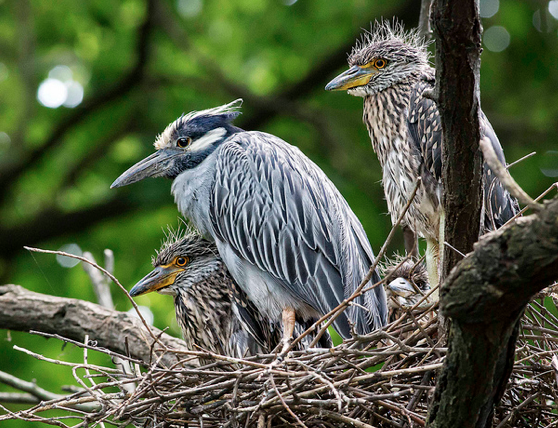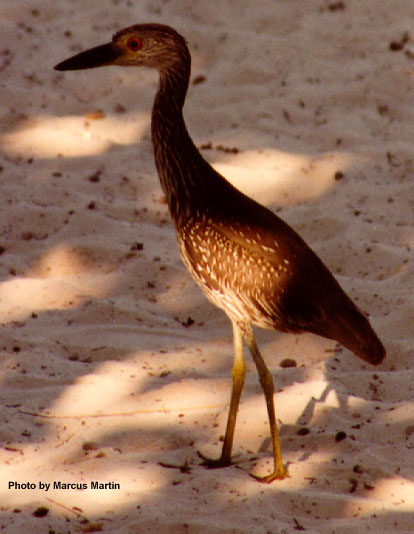Life History and Reproduction
The life cycle and reproductive process of the yellow-crowned
night heron is typical of other birds, however, many behaviors
throughout the growth and maturation of the night heron differ
from other species.
 In preparation for reproduction, yellow-crowned night herons
assemble nests of sticks. Both the male and female heron assist
in nest construction (Bagley and Grau 1980). They typically
build their nests about 15 meters above ground (Watts 1989);
nesting high in trees allows for evasion of predators on land,
which is a major source of offspring loss (Wischusen 1980).
Nyctanassa violacea parents also prevent predation of their
young, as well as mate and material theft, by facing opposite
directions in the nest. Nest mates that face different
directions while nesting have a greater range of threat
surveillance, and therefore, greater reproductive success and a
reduced risk of being attacked. Those that do not face opposing
sides of the nest have greater odds of predation, a diminished
probability of protecting their young, and a smaller chance of
passing on their genes to the next generation (Afkhami and
Strassmann 2007).
In preparation for reproduction, yellow-crowned night herons
assemble nests of sticks. Both the male and female heron assist
in nest construction (Bagley and Grau 1980). They typically
build their nests about 15 meters above ground (Watts 1989);
nesting high in trees allows for evasion of predators on land,
which is a major source of offspring loss (Wischusen 1980).
Nyctanassa violacea parents also prevent predation of their
young, as well as mate and material theft, by facing opposite
directions in the nest. Nest mates that face different
directions while nesting have a greater range of threat
surveillance, and therefore, greater reproductive success and a
reduced risk of being attacked. Those that do not face opposing
sides of the nest have greater odds of predation, a diminished
probability of protecting their young, and a smaller chance of
passing on their genes to the next generation (Afkhami and
Strassmann 2007).
Like all birds, yellow-crowned night herons undergo sexual
reproduction. Once the eggs have been fertilized and laid, they
have to be incubated until they are ready to hatch. Contrary to some
avian species, both the male and female heron will incubate the
eggs (Bagley and Grau 1980). When the young herons hatch, the
paternal herons feed the offspring a mixture of small crab and
insect pieces that are similar to the adult diet (Watts
1988). Both the male and female heron feed their young, a
behavior not found in some bird species (Bagley and Grau 1980).
Though yellow-crowned night herons become independent from their
parents within four to nine weeks of birth, they will not
develop adult plumage necessary for mating until they reach two
years of age (Wingate 1982).

When the herons reach reproductive age, they begin searching for
a mate. Yellow-crowned night herons are monogamous, so finding a
mate is an important task (Afkhami and Strassmann 2007). These
night herons use several behaviors, such as vocal calls, flying
patterns, and displays in mate attraction. When two birds decide
to mate, the male mounts the female and insemination occurs.
Fertilization of the eggs occurs within the female, where they
will develop until they are ready to be laid. Then the chicks
will hatch, grow, and sexually mature until reproduction occurs
and the cycle will begin again (Bagley and Grau 1980).
Though the life cycle of the yellow-crowned night heron relates
to other avian species, there are key behavioral and procedural
differences in nesting, feeding, mating, and incubating habits
in the life and reproductive cycles of these birds. As you will
see on the next page, some of these behaviors of the
yellow-crowned night heron impact the
interactions it has with
other species.
Home